a very belated post on the Grand Opening of the Pier Park
Yep, we got rained on, but we still had a great time.
Even I was surprised to learn about some of the challenges faced by the environmental engineers working on the site. Back in late April, I was able to tour the not-yet-completed site with some of those engineers as tour guides, as part of a tour organized by the Environmental Managers Association of BC.
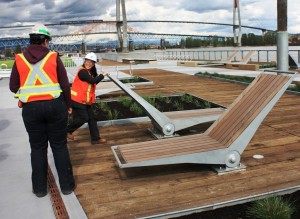 |
| Environmental Professionals at work. Don’t try this at home, kids. |
We all know the New Westminster waterfront is historic, and has a rich industrial and commercial history, gong back further than pretty much anywhere else in BC. For heritage buffs or park programming planners, that is great. For engineers trying to clean up an abandoned contaminated site, that sounds like a whole pile of headaches, wrapped in pitfalls, and dipped in a deep pool of budget-straining hassles.
A couple of interesting stories about the New West waterfront especially stood out in my mind, and gave me headaches of empathy. Most have to do with the challenge of how people used to use the waterfront in the days when diesel was sold for five cents a gallon (think about it, how careful would you be spilling something that costs less than tap water?)
We all know the story of New Westminster’s great fire of 1898. Not many of us know that at the time of the great fire, the waterfront was somewhere just north of the current Front Street. The rest of the land between there and the river is mixed landfill material, and the first layer was the bulldozed debris of the great fire. Pushing twisted metal and scorched wood debris into the river seemed to make sense at the time.
Of course, society went through a pretty libertarian phase with the industrial revolution and the development of the colonies, and we never imagined we could cause harm to something as big as the environment. The river, although it was the source of much of our water and food, was also seen as a great place to let nature take away our trash. (“The ocean is the planet’s liver”, a good buddy of mine says, explaining why he won’t eat seafood). A good example of this is the piles of metal turnings found under the old pier.
Apparently, there was once a machine shop on the pier, and machine shops turn out a lot of metal shavings (back before it was cost-efficient to recycle them), most of them immersed in cutting fluids. At the time, it made perfect sense to cut a hole in the floor of the pier and let those shavings fall into the river. Until they accumulated up to the level of the pier. Then you cover the hole and cut another one a few meters over (well, back then, a few yards or furlongs or cubits over, I suppose), and start again.
In 2012, those piles of metals shavings immersed in hydrocarbons are called “contamination”, up to the point where they could be considered hazardous waste. Just removing them from the river sediments is a technical challenge, as you must first stabilize them or isolate them, so they do not spread around in the river sediments as you are cleaning them up, all the while working in water with a 3 knot current, and avoiding fisheries windows so your work does not impact migrating salmon.
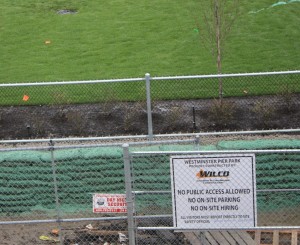 |
| The Cities where I have seen Wilco Play: Champaign, Illinois; Las Vegas, Nevada; Vancouver, BC; and (this upcoming September) San Franciso, California. Love me some Wilco. |
Ten there is the infamous “Toxic Blob”. This is a small plume of chlorinated solvents (essentially drycleaning fluid and related compounds) that was discovered at depth along one edge of the property. The source of the contamination was not on the Park property, but some of it was migrating with groundwater under the property, and in order for the Park to receive a clean bill of environmental health (called a “certificate of compliance”) from the Ministry of Environment, that blob had to be stopped. Problem being it was 22m below the surface, and those cleaning up the park had no access to the source area, as it wasn’t on the Park land.
The only practical option available is to install a barrier wall to stop the flow, but how do you install a waterproof wall 22m below the surface while trains are rolling by a few meters over on one side, and piles are being driven for soil stabilization a few meters to the other side? Digging up the ground to that depth would require some serious shoring up the rails to hold laden trains up, stopping nearby soil stabilization work, and pumping out a whole lot of groundwater. The first creates a lot of risk, the second puts the rest of the pier park project off schedule and threatens the tight deadline required to get under the federal funding window, the third requires you do something with all that potentially-contaminated groundwater without violating the fisheries act or waste management act. Digging was not an option.
Sub-surface walls can be built without digging by driving sheet piles. this is just like driving regular piles, but with interlocking sheets of thick steel plate: Horribly expensive interlocking sheets of steel plate when they are 25m long. This is also a time-consuming process, and with all of that unknown fill material down below, not guaranteed to be feasible. Sheet pile is often like the unstoppable force vs. the impenetrable surface problem.
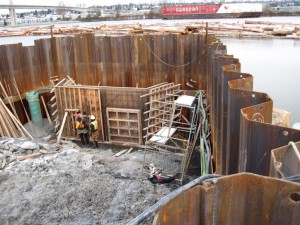 |
| Sheet piles used for shoring in another location on the Fraser River |
A better solution was found in an innovative approach involving jet grout. Essentially, they drilled a line of holes, and put a device down each hole that shot concrete grout out the sides of borehole. Given enough holes and a powerful enough jet to bridge the gap between holes, an entire impermeable concrete/grout wall can be injected. There were still some significant technical challenges with assuring the holes remained aligned all the way down (drill holes tend to deviate over 22m!) which were solved using an innovative down-hole GPS system. Inject the wall, install a couple of monitoring wells to make sure the groundwater (and chlorinated solvents) are not leaking through, and Bobs Yer Uncle. Best part was that it could be done while the rest of the work on the Park was being completed.
That is the most remarkable part of this project, actually. Besides the technical challenges, it was simply not possible to do it in the “normal” Brownfields way. That would be: investigate first, complete remediation, then plan and construct above the cleaned-up site. Because the Federal portion of the money came with a tight deadline to completion, there was simply no time to wait for the preliminary and remediation work to be done before the soil stabilization and deck refurbishment work had to start. So the remediation work was ongoing during pile driving and pier construction: Two or three teams working independently on the same site. To use a sports analogy, it would be like having a baseball game and a football game happening simultaneously on the same field, while someone is mowing the grass: An organizational nightmare.
| Suited up and suitably impresssed Environmental Professionals. |
Even the Grand Opening was well attended and cheery – despite the pouring rain.
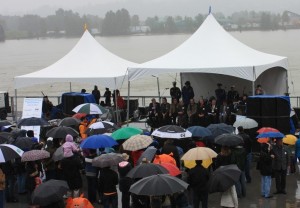
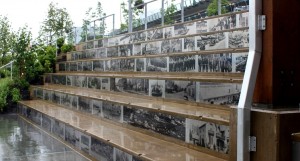
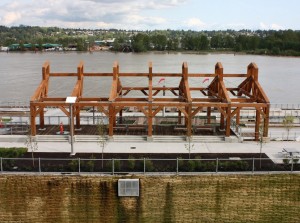
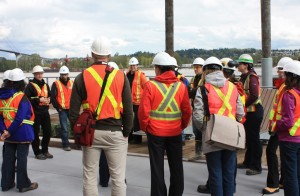
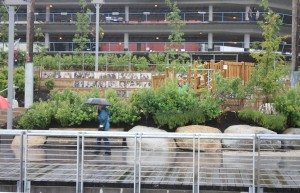
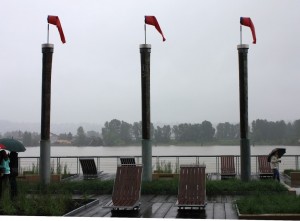
Interesting stuff and a great post. They should have this info displayed somewhere in the park for people who are interested.